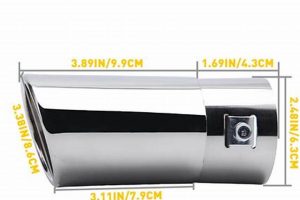Material employed within a vehicle’s exhaust system to dampen sound and reduce noise output can be sourced and prepared outside of commercial manufacturing. This involves the selection and preparation of heat-resistant substances, such as fiberglass matting or steel wool, to be tightly packed within the muffler casing. An example would be the careful layering of a specifically chosen woven fabric around the internal components of a motorcycle muffler to achieve a desired acoustic profile.
The practice offers potential cost savings and customization options compared to purchasing pre-made components. Historically, this method provided a means for individuals to maintain or modify exhaust systems when access to specialized parts was limited. The acoustic characteristics and performance of a vehicle’s exhaust system can be tailored to specific preferences through careful selection and implementation of these materials, impacting perceived engine sound and potentially influencing exhaust flow dynamics.
The subsequent sections will detail various materials suitable for this purpose, alongside recommended packing techniques and safety precautions. Furthermore, consideration will be given to the long-term durability and potential environmental impact associated with different choices. Finally, a comparative analysis will be made against commercially available alternatives, highlighting the tradeoffs between cost, performance, and longevity.
Essential Considerations for Effective Exhaust Dampening
The following provides critical guidance when employing alternative acoustic absorption methods within a vehicle’s exhaust system. Careful attention to these details promotes safety, performance, and longevity.
Tip 1: Material Selection is Paramount: Choose exclusively high-temperature-rated substances. Fiberglass, stainless steel wool, and ceramic-based textiles are viable options. Avoid flammable materials or those that produce toxic fumes when heated. For example, household insulation is categorically unsuitable due to its low melting point and potential for harmful emissions.
Tip 2: Density Management: The tightness of the material impacts sound absorption. Excessive compaction restricts exhaust flow, reducing engine performance. Insufficient density leads to premature burnout and ineffective sound reduction. Experimentation with varying packing pressures is often necessary to achieve the desired balance.
Tip 3: Internal Structure Preparation: Before introducing the sound-dampening material, thoroughly clean the muffler’s interior. Remove any rust, debris, or remnants of the old packing. This promotes proper adhesion and prevents premature degradation of the new material. Consider applying a high-temperature sealant to internal seams to further improve longevity.
Tip 4: Layering Techniques: Introduce the material in thin, even layers rather than in large clumps. This ensures consistent density and uniform sound absorption. For example, wrapping layers of fiberglass matting around the perforated core of a muffler allows for better acoustic control.
Tip 5: Securing the Packing: Once the material is in place, ensure it is adequately secured to prevent shifting or ejection. Utilize high-temperature wire or metal mesh to contain the packing within the muffler body. Improper securing can lead to material clogging exhaust ports and reducing engine power.
Tip 6: Safety Precautions: Wear appropriate personal protective equipment, including gloves, a respirator, and eye protection, when handling raw materials. Some substances, such as fiberglass, can cause skin and respiratory irritation. Work in a well-ventilated area to minimize exposure to fumes.
Tip 7: Regular Inspection: Periodically inspect the exhaust system for signs of wear or damage. Check for leaks, unusual noises, or a decrease in performance. Promptly address any issues to prevent further damage and maintain optimal performance. The longevity of the material depends on operating conditions and the quality of materials selected.
Adherence to these guidelines will maximize the effectiveness and safety of this approach, providing a means to manage exhaust noise and potentially enhance engine performance. Proper selection, application, and maintenance contribute to a reliable and long-lasting exhaust system.
The following sections will explore the safety concerns and legal regulations associated with modifying exhaust systems and sound emissions.
1. Material Heat Resistance
Material heat resistance is a paramount consideration when undertaking the process of creating muffler packing outside of a controlled manufacturing environment. The capacity of a substance to withstand high temperatures generated by exhaust gases directly influences the performance, longevity, and safety of the modified exhaust system.
- Degradation Prevention
The primary role of heat resistance is to prevent premature degradation of the packing material due to thermal decomposition. Materials lacking sufficient heat tolerance will break down, leading to a loss of sound-dampening capabilities and potential clogging of the exhaust system. For instance, using standard household insulation, which has a low melting point, would result in rapid disintegration and system failure.
- Combustion Prevention
High temperatures within an exhaust system can ignite flammable materials. Selecting substances with high ignition points is crucial to avoid fire hazards. For example, untreated cotton or synthetic fabrics are unsuitable due to their propensity to combust at relatively low temperatures, posing a significant safety risk.
- Toxic Emission Mitigation
Certain materials, when exposed to extreme heat, release toxic fumes. Employing heat-resistant alternatives minimizes the risk of harmful emissions being expelled from the exhaust system. An example would be avoiding certain plastics that, upon heating, can release dangerous gases into the environment.
- Structural Integrity Maintenance
Heat resistance is essential for maintaining the structural integrity of the packing. Materials that soften or melt under high temperatures can shift within the muffler, leading to uneven packing density and reduced sound absorption. Materials like stainless steel wool or high-temperature fiberglass are preferred because they retain their form and function even when exposed to extreme heat.
In summation, appropriate material heat resistance is not merely a factor in the effectiveness of muffler packing, it is fundamental to the operation. Neglecting this element can lead to system failure, safety hazards, and environmental concerns. The selection of suitable, heat-tolerant substances is therefore a crucial step in modifying or repairing an exhaust system using packing material prepared outside of commercial settings.
2. Packing Density Impact
The density with which material is packed within a muffler directly influences its sound-dampening capabilities and the overall performance of the exhaust system. This aspect becomes particularly crucial when implementing acoustic absorption methods outside of standardized manufacturing processes, where precision control is often more challenging.
- Acoustic Absorption Efficiency
The material’s ability to absorb sound waves is directly proportional to its density, up to a certain threshold. Insufficient density allows sound waves to pass through relatively unimpeded, resulting in minimal noise reduction. For instance, loosely packed fiberglass will be far less effective at muffling engine noise than tightly compressed layers. However, excessive density can also hinder absorption by reflecting sound waves rather than allowing them to penetrate the material.
- Exhaust Flow Restriction
Overly dense packing can significantly impede the flow of exhaust gases, increasing backpressure within the system. Elevated backpressure reduces engine efficiency, leading to decreased horsepower and fuel economy. Consider a scenario where steel wool is packed so tightly that it creates a near-solid barrier within the muffler. The resulting exhaust restriction will demonstrably affect engine performance.
- Material Longevity
Packing density also influences the durability of the material. If the packing is too loose, vibrations and exhaust gas pulsations can cause it to shift and degrade rapidly. Conversely, excessive compaction can accelerate wear due to increased friction and heat buildup. A moderately compressed packing material, properly secured within the muffler, will generally exhibit a longer lifespan.
- Harmonic Resonance Alteration
The packing density affects the resonant frequencies of the exhaust system. Adjusting the density allows for fine-tuning the exhaust note, either to achieve a deeper rumble or to eliminate unwanted high-frequency sounds. Varying the compression of the packing material around the core of a muffler allows a user to slightly modify the acoustic output.
These considerations highlight the interconnectedness of packing density, sound absorption, exhaust flow, material longevity, and harmonic resonance within the context of do-it-yourself or non-standard procedures. Achieving the desired balance necessitates careful selection of materials, precise packing techniques, and ongoing monitoring of the exhaust system’s performance.
3. Structural Integrity Retention
Structural integrity retention refers to the ability of muffler packing material, especially that prepared outside of commercial settings, to maintain its form and arrangement within the exhaust system over time. This characteristic directly impacts noise reduction effectiveness and exhaust flow dynamics. Loss of structural integrity causes the packing to shift, degrade, or be expelled from the muffler, negating its intended purpose. The causes for this are numerous, including thermal stress, vibration, and chemical attack from exhaust gases.
The materials chosen directly influence how well the packing retains its structure. For instance, tightly woven fiberglass matting generally resists shifting and compaction better than loosely packed mineral wool. Furthermore, securing the packing properly is critical. Wrapping the packing around the perforated core of the muffler and using high-temperature wire or metal mesh to contain it prevents it from being blown out by exhaust pulses. If this step is omitted, the packing’s structural integrity is quickly compromised, leading to diminished performance and potentially damaging engine components.
In summary, preserving the structural integrity of packing in non-standard muffler applications is paramount for long-term effectiveness. Careful material selection, proper packing techniques, and robust securing methods are essential to prevent degradation and maintain the muffler’s intended noise reduction and performance characteristics. Neglecting structural integrity will invariably result in a compromised exhaust system and potential engine damage. Subsequent analysis will explore the connections between these aspects and acoustic tuning.
4. Acoustic Property Customization
The practice of constructing muffler packing outside of commercial manufacturing processes offers a unique avenue for adjusting a vehicle’s exhaust sound profile. This adaptability allows vehicle operators and modifiers to tune their exhaust notes to meet specific aesthetic, performance, or regulatory requirements.
- Material Selection for Tone Shaping
The materials employed directly influence the resulting sound characteristics. Different substances resonate and absorb sound frequencies in distinct ways. For example, stainless steel wool tends to produce a sharper, more metallic tone, while fiberglass batting typically results in a deeper, more subdued exhaust note. Selection allows a nuanced shaping of the sonic output.
- Density Tuning for Volume Control
The compactness of the packing affects the overall loudness of the exhaust. Denser packing generally provides greater sound attenuation, resulting in a quieter exhaust. Conversely, looser packing allows for a louder and more aggressive sound. Experimentation with packing density enables a fine-grained control over volume.
- Chambering and Baffling Integration
The addition of internal chambers or baffles within the muffler, in conjunction with strategically placed packing, can further refine the sound. Chambers alter resonant frequencies and baffle plates disrupt sound waves. The construction of these internal components, often achievable in non-commercial contexts, enables a detailed manipulation of the exhaust’s acoustic properties.
- Resonance Adjustment for Specific Frequencies
By carefully selecting packing materials and configuring internal muffler geometries, specific frequencies can be emphasized or suppressed. This capability allows for the elimination of undesirable droning sounds or the amplification of more pleasing tones. Manipulating the resonance characteristics requires an understanding of acoustic principles.
The flexibility afforded through the creation of packing allows for a degree of exhaust sound tailoring that may not be readily available with commercially manufactured mufflers. However, achieving optimal results necessitates careful consideration of material properties, packing techniques, and acoustic principles.
5. Exhaust Flow Considerations
Exhaust flow constitutes a critical factor directly affected by the methodology and materials employed in generating muffler packing. The design and execution of exhaust modifications using alternative packing methods must carefully balance sound attenuation with maintaining efficient gas expulsion from the engine. Improperly executed packing methods can severely restrict exhaust flow, leading to detrimental effects on engine performance and longevity. This can manifest as reduced horsepower, diminished fuel economy, and increased engine operating temperatures due to elevated backpressure. For instance, tightly packing a muffler with dense steel wool, while potentially effective at noise reduction, creates a significant obstruction to the outflow of exhaust gases. This, in turn, increases pressure within the exhaust manifold and cylinders, hindering the engine’s ability to efficiently expel spent gases and draw in fresh air/fuel mixture.
Conversely, inadequate packing or the use of materials prone to rapid degradation can lead to a loss of sound attenuation and an increase in exhaust velocity, but with an uneven flow distribution. This situation, while avoiding excessive backpressure, may result in an unacceptably loud exhaust note and potential turbulence within the exhaust system, further reducing efficiency. Real-world examples include poorly executed modifications using materials such as loosely packed fiberglass batting, which tend to burn out and compact unevenly, creating flow disruptions. The design should also consider the gas dynamics of the exhaust stream. Smooth bends and transitions in the muffler’s internal structure, combined with appropriately selected packing materials, can optimize exhaust velocity and minimize turbulence. This principle is often applied in high-performance applications, where carefully crafted exhaust systems are used to maximize engine output.
The significance of understanding exhaust flow considerations when undertaking muffler modifications is underscored by the potential for both performance gains and catastrophic engine damage. The creation of custom packing must involve a careful evaluation of materials, packing density, and internal muffler design to achieve a balance between sound reduction and efficient gas expulsion. The challenges involved in precisely calculating and measuring exhaust flow without specialized equipment necessitate a meticulous approach and a thorough understanding of basic engine principles. The long-term reliability and environmental impact of these systems are also crucial components to consider, ensuring modifications align with both personal performance goals and responsible engineering practices.
Frequently Asked Questions Regarding “Homemade Muffler Packing”
The following addresses common inquiries and misconceptions surrounding the practice of creating muffler packing outside of commercial manufacturing environments. It aims to provide clear, objective information to inform responsible decision-making.
Question 1: Is the creation of muffler packing a cost-effective alternative to purchasing commercially manufactured mufflers?
The potential for cost savings exists; however, it is contingent upon the availability of suitable materials and the skill of the individual performing the work. The time investment, potential for errors, and the possibility of needing to re-do the packing should be factored into the economic assessment. Additionally, the longevity and performance of commercially produced mufflers often exceed that of packing created outside of a controlled manufacturing environment.
Question 2: What materials are considered suitable for use as muffler packing?
Only materials specifically designed to withstand high temperatures and resist combustion or decomposition should be employed. Acceptable options include fiberglass matting, stainless steel wool, and certain ceramic-based textiles. Avoid using flammable materials, substances that emit toxic fumes when heated, or materials with low melting points.
Question 3: Does the packing density influence the performance of the exhaust system?
Yes. Packing density directly impacts sound attenuation and exhaust flow dynamics. Excessive density can restrict exhaust flow, reducing engine performance, while insufficient density results in inadequate noise reduction. The ideal packing density is a balance between these two factors, often requiring experimentation to achieve optimal results.
Question 4: Are there any legal or regulatory restrictions pertaining to modifying exhaust systems?
Exhaust modifications are subject to local, state, and federal regulations regarding noise emissions. Altering an exhaust system to exceed permissible noise levels may result in fines or legal penalties. Prior to undertaking any modifications, it is imperative to research and comply with all applicable regulations.
Question 5: How can the structural integrity of muffler packing be maintained over time?
Maintaining structural integrity requires selecting durable materials, employing proper packing techniques, and adequately securing the packing within the muffler. The packing should be tightly wrapped around the perforated core and secured with high-temperature wire or metal mesh to prevent shifting or ejection.
Question 6: What are the primary safety precautions to observe when creating muffler packing?
Appropriate personal protective equipment, including gloves, a respirator, and eye protection, should be worn when handling raw materials. Work in a well-ventilated area to minimize exposure to fumes. Ensure that all materials are properly secured within the muffler to prevent them from being ejected into the exhaust stream. Exercise extreme caution when working with hot exhaust components.
These frequently asked questions serve to provide a basic understanding of the practice. However, it does not represent comprehensive guidance. Individuals contemplating the creation of muffler packing should conduct thorough research and exercise sound engineering judgment.
The following section will detail potential challenges and drawbacks of this approach.
Conclusion
The preceding exploration has presented a comprehensive overview of crafting noise-dampening material outside of traditional manufacturing settings. The analysis addressed material selection, packing techniques, performance implications, safety considerations, and legal ramifications associated with this practice. While the prospect of cost savings and acoustic customization may be appealing, it is crucial to recognize the complexities and potential risks involved.
Before undertaking this pursuit, individuals should carefully weigh the potential benefits against the inherent challenges. Thorough research, meticulous execution, and strict adherence to safety protocols are essential for mitigating risks and ensuring responsible outcomes. If improperly implemented, modifications could compromise engine performance, violate noise regulations, or create hazardous conditions. Consider expertise and legality before modifying the vehicle exhaust system.







